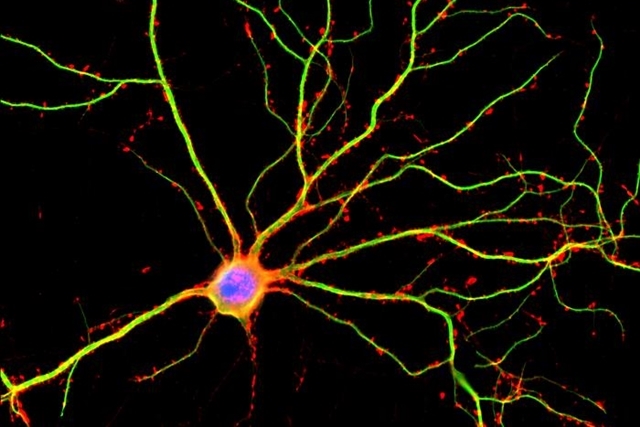18 Feb. 2022. Light-activated stimulation of a precise set of nerve cells in the brainstem is shown to improve motor abilities in lab mice induced with Parkinson’s disease. A neuroscience team from University of Copenhagen in Denmark describe their techniques in the 26 Jan. issue of the journal Nature Communications.
Parkinson’s disease occurs when the brain produces less of the amino acid dopamine, a neurotransmitter that sends signals from one neuron or nerve cell to another. As the level of dopamine lowers, people with Parkinson’s disease become less able to control their bodily movements and emotions. Tremors associated with Parkinson’s disease can be treated with deep-brain stimulation, where an implanted device surgically sends electrical signals into affected brain regions, but the technique does not improve basic motor abilities like walking.
Copenhagen neuroscientist Ole Kiehn investigates nerve cell circuits affecting motor activity in the body. Among the lab’s research are studies of neuronal circuits connecting the brainstem, the lower stalk-like part of the brain, with the spinal cord, particularly when dysfunctions in those circuits result in movement disorders like Parkinson’s disease. Kiehn and postdoctoral researcher Debora Masini, the paper’s first author, note that in people with Parkinson’s disease, reductions in dopamine affect neuron circuits in the basal ganglia, a region in the brain responsible for motor control.
The authors indicate another part of the brain called the pedunculopontine nucleus or PPN, located in the brainstem, also has neurons emitting signals affecting motor activity, but it first depends on signals from the basal ganglia. Masini and Kiehn hypothesize that using deep brain stimulation to activate certain responsive neurons, found in the caudal or tail-like area of the PPN, could overcome the loss of locomotion signals from the basal ganglia when dopamine is reduced.
Viruses expressing light-emitting proteins
The researchers induced Parkinson’s-like symptoms in a set of lab mice by chemically blocking dopamine production, which caused the animals to slow or stop motor activity. Tests show by blocking dopamine production, the mice emitted fewer motor activity signals from their basal ganglia to PPN neurons. Masini and Kiehn delivered stimulation to neurons in the PPN caudal area, using adeno-associated viruses, genetically altered benign viruses often used for gene therapy. In this case, the viruses expressed optogenetic or light-emitting proteins to stimulate the target neurons.
The authors say mice receiving the light-activated stimulation to the PPN exhibit normal leg movements. “When we stimulated these specific neurons in the caudal area of the PPN,” says Masini in a university statement, “the animals were able to walk normally, across longer distances and with normal walking speed, as opposed to before the stimulation, where they would display symptoms of Parkinson’s disease.”
Masini adds, “We systematically compared stimulation of different locations and cell types in a series of complementary experiments. And they all pointed towards the same conclusion. It strongly indicates these excitatory neurons in the caudal PPN are an ideal target for recovery of movement loss.”
Kiehn notes that advancing these techniques to clinical trials with electronic deep brain stimulation should proceed cautiously, since only caudal PPN neurons can be safely targeted. “It is a very delicate area,” says Kiehn, “because if we were to stimulate excitatory neurons in other areas than the caudal PPN, it would cause complete immobilization instead.”
More from Science & Enterprise:
- Data Partnership Aims for Precise Parkinson’s Care
- FDA Okays Trial of Donated Stem Cells for Parkinson’s
- Apple Watch Helps Personalize Parkinson’s Care
- Trial to Test CBD for Parkinson’s-Related Psychosis
- Sensors, Algorithm Personalize Parkinson’s Therapy
We designed Science & Enterprise for busy readers including investors, researchers, entrepreneurs, and students. Except for a narrow cookies and privacy strip for first-time visitors, we have no pop-ups blocking the page, nor distracting animated GIF graphics. If you want to subscribe for daily email alerts, you can do that here, or find the link in the upper left-hand corner of the desktop page. The site is free, with no paywall. But, of course, donations are gratefully accepted.
* * *


 RSS - Posts
RSS - Posts
You must be logged in to post a comment.